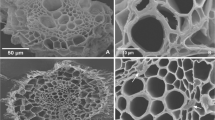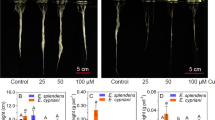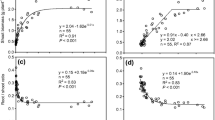Abstract
Elsholtzia argyi and Elsholtzia splendens, which are Chinese endemic Pb/Zn mined and Cu mined ecotype respectively, were investigated on the aspect of their response to Pb toxicity in the presence or absence of EDTA addition. After 8 d's Pb treatment, root length, root surface area and root volume of E. splendens decreased much more than those of E. argyi, and reduced considerably with increase of Pb, while no marked change was noted for root average diameter. Compared to E. argyi, length of root with diameter (D)<0.2 mm was significantly reduced for E. splendens as Pb increased. D<0.1 mm E. splendens root had cross-sectional surface area at Pb≥10 mg/L, while for E. argyi, it was at Pb≥25 mg/L. With increase of Pb, DW of E. splendens decreased much more than that of E. argyi. E. argyi exhibited much more tolerance to Pb toxicity thanE. splendens. Treatment with 100 mg/L Pb plus 50 mmol/L EDTA significantly decreased the length and surface area of D≤0.2 mm root, increased the length and surface area of 0.2≤D≤0.8 mm root for the case of E. argyi, while for E. splendens, length and surface area of D<0.6 root reduced, as compared to 100 mg/L Pb treatment, alone. At 100 mg/L Pb, shoot Pb accumulation in E. splendens and E. argyi were 27.9 and 89.0 μg/plant DW respectively, and much more Pb was uptaken by the root and translocated to the stem of E. argyi as compared to E. splendens. Treatment of the plant with 100 mg/L Pb plus 50 mmol/L EDTA increased leaf Pb accumulation from 16.8 to 84.9 g/plant for E. splendens and from 18.8 to 52.5 g/plant for E. argyi, while both root and stem Pb pronouncedly reduced for both Elsholtzia species. The increased translocation of Pb to the leaf of E. splendens being than that of E. argyi after treatment with 100 mg/L Pb plus 50 mmol/L EDTA should be further investigated.
Similar content being viewed by others
References
Baker, A.J.M., Brooks, R.R., 1989. Terrestrial higher plants which hyperaccumulate metallic elements: A review of their distribution, ecology and photochemistry.Biorecovery,1:81–126.
Blaylock, M., Salt, D.E., Dushenkov, S., Zakharova, O., Gussman, C., Kapulnik, Y., Ensley, B.D., Raskin, I., 1997. Enhanced accumulation of Pb inIndian Mustard by soil-applied chelating agents.Environmental Science and Technology,31:860–865.
Huang, J.W., Cunningham, S.D., 1996. Lead phytoextraction: Species variation in lead uptake and translocation.New Phytologist,134:75–84.
Jarvis, M.D., Leung, D.W.M., 2001. Chelated lead transport inChamaecytisus proliferus (L.f.) link ssp.proliferus var.palmensis (H. Christ): An ultrastructural study.Plant Science,161:433–441.
Marschner, H., 1995. Mineral Nutrition of Higher Plants. 2nd Ed., Academic Press, San Diego, CA, USA.
Peng, H.Y., Yang, X.E., 2005. Volatile constituents in the flowers ofElsholtzia argyi and their variation-a possible utilization of plant resources after phytoremediation.Journal of Zhejiang University SCIENCE,6B(2):91–95
Raskin, I., Smith, R.D., Salt, D.E., 1997. Phytoremediation of metals: Using plants to remove pollutants from the environment.Current Opinion in Biotechnology,8:221–226.
Reeves, R.D., Brooks, R.R., 1983. Hyperaccumulation of lead and zinc by two metallophytes from a mine area in Central Europe.Environmental Pollution Ser A,31:275–283.
Salt, D.E., Michael, B., Nanda, P.B.A.K., Viatcheslav, D., Burt, D.E., Ilan, C., 1995. Phytoremediation: A novel strategy for the removal of toxic metals from the environment using plants.Biotechnology,13:468–474.
Scott, D.C., David, W.O., 1996. Promises and prospects of phytoremediation.Plant Physiology,110:715–719.
Song, J., Zhao, F.J., Luo, Y.M., McGrath, S.P., Zhang, H., 2004. Copper uptake byElsholtzia splendens andSilene vulgaris and assessment of copper phytoavailability in contaiminated soils.Environmental Pollution,128:307–315.
Yang, X.E., Shi, W.Y., Fu, C.X., Yang, M.J., 1998. Copper-Hyperaccumulators of Chinese Native Plants, Characteristics and Possible Use for Phytoremediation. Sustainable Agriculture for Food, Energy and Industry, James & James (Science Publishers) Ltd.
Author information
Authors and Affiliations
Corresponding author
Additional information
Project supported by the National Basic Research Program (973) (No. 2002CB410804) of China and the National Natural Science Foundation of China (No. 20307008)
Rights and permissions
About this article
Cite this article
Peng, Hy., Tian, Sk. & Yang, Xe. Changes of root morphology and Pb uptake by two species of Elsholtzia under Pb toxicity. J Zheijang Univ Sci B 6, 546–552 (2005). https://doi.org/10.1631/jzus.2005.B0546
Received:
Accepted:
Published:
Issue Date:
DOI: https://doi.org/10.1631/jzus.2005.B0546




